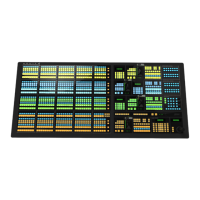Keying
Keying is the term used to describe when you insert (or
electronically cut) portions of one scene into another, or
place titles over background images. Keys are made up
of two basic components, an alpha, that cuts the hole in
the background video, and a ll, that lls the hole with
different video. Depending on the type of key, the alpha
signal can be from an external source, or internally
generated.
Keys, like MEs, are layered onto the background video
from the lowest number key to the highest number key
on the ME by default.
Self Key
A Self Key is a key in which the luminance, or
brightness, values of the key source is used as the alpha
for the key.
To Set Up a Self Key
1. Press the SEL button on the Keyers module for the
key you want to set up and select a video source on
the Key bus.
Tip: The SEL button allows you to quickly select the keyer
you want to work with and assign the Key bus to the keyer.
On the Double-Down control panel, the top button row is
assigned to the even numbered keyers (2,4,6,8) and the
button row below is assigned to the odd numbered keyers
(1,3,5,7). This can be changed with the DD Key Delegation
personality option.
2. Press SELF KEY.
3. Press Clip/Gain and use the Clip and Gain knobs
to adjust the clip and gain of the key.
• Clip — remove lower-saturated colors from the
video image.
• Gain — adjust the transition between the video
image and the parts of the video image that are
removed.
Tip: You can return the clip and gain values to the default
setting by pressing Make Key Linear.
4. Press Trans Rate and use the Trans Rate knob
to set the independent key transition rate.
5. Toggle Transparency to On and use the Transp.
knob to adjust the transparency of the key from
opaque (0%) to fully transparent (100%).
6. Toggle Additive to temporarily override the
shaped/unshaped key settings for the selected source.
• On — turn shaped keying on for the source.
• Off — turn unshaped keying on for the source.
Auto Select Key
An Auto Select Key is a key in which two video signals
are required to make the key. The Alpha is used to cut
the hole in the video and the ll is used to ll the hole.
These signals often originate from external devices such
as character generators, external still stores, or other
graphics systems.
An auto select key is set up by selecting the key and video
source you want to use, and adjusting the key parameters.
The pairing of the video and alpha video signal is done
when conguring video inputs. Refer to the Setup Manual
that came with your switcher for information on setting
up Auto Keys.
To Set Up an Auto Select Key
1. Press the SEL button on the Keyers module for the
key you want to set up and select a video source on
the Key bus.
Tip: The SEL button allows you to quickly select the keyer
you want to work with and assign the Key bus to the keyer.
On the Double-Down control panel, the top button row is
assigned to the even numbered keyers (2,4,6,8) and the
button row below is assigned to the odd numbered keyers
(1,3,5,7). This can be changed with the DD Key Delegation
personality option.
2. Press AUTO SELECT.
3. Press Clip/Gain and toggle Key Mem to Off.
When key memory (Key Mem) is on, you cannot
adjust the clip and gain settings.
4. Use the Clip and Gain knobs to adjust the clip and
gain of the key.
• Clip — remove lower-saturated colors from the
video image.
• Gain — adjust the transition between the video
image and the parts of the video image that are
removed.
Tip: You can return the clip and gain values to the default
setting by pressing Make Key Linear.
5. Press Trans Rate and use the Trans Rate knob
to set the independent key transition rate.
6. Toggle Transparency to On and use the Transp.
knob to adjust the transparency of the key from
opaque (0%) to fully transparent (100%).
7. Toggle Additive to temporarily override the
shaped/unshaped key settings for the selected source.
• On — turn shaped keying on for the source.
• Off — turn unshaped keying on for the source.
46 • Keying — Acuity Operation Manual (v9.2)

